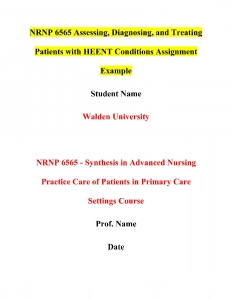How to Write Nursing Term Papers: Tips & Guidance

Nursing is a complex subject that deals with a wide range of diverse concepts and situations. Nursing, as a healthcare profession, provides a fundamental foundation for healthcare workers while also ensuring specialized education for nurses through patient practice and care. As a result, nursing research is of crucial scientific importance since it has the potential to improve nursing practice and care quality.
The nursing term paper is a sort of written project that is typically done by students majoring in nursing, healthcare, or other specialized disciplines. Students are typically obliged to produce a Nursing term paper at the conclusion of the course and to develop practical skills by researching their theoretical foundation and conducting their own research.
The project bears a strong resemblance to a research paper. However, the term paper, as a demonstration of acquired knowledge and expertise, necessitates a more in-depth study involving the use of various statistics and complex techniques. To earn a high grade on your Nursing term paper, you must adhere to the professor’s criteria and conduct independent research on a pertinent topic. Given the connection between nursing and healthcare and medical sciences, it is critical to approach the issue of your analysis from a variety of angles. Additionally, you should bolster your thesis with arguments and examples based on credible factual and statistical facts. A critical review of the author’s primary results and findings is a necessary component of a successful nursing term paper. Everything said previously demonstrates how difficult it is to prepare a high-quality Nursing term paper. However, by following a few nursing term paper writing ideas, you may simplify the process and make it more enjoyable and understandable.
Writing a Nursing Term Paper: The Do’s and Don’ts!
Do’s:
- Start early: Give yourself enough time to research, write, and edit your paper. Starting your research early to ensures that you have enough time to gather and analyze information
- Choose a relevant and interesting topic: Make sure your topic is related to the course and that you are genuinely interested in it.
- Research extensively: Use credible sources such as academic journals and books to gather information for your paper and support your arguments.
- Organize your paper: Organize your paper into clear sections with headings and subheadings to make it easy to follow.
- Use proper citation: Cite all sources used in your paper in the correct format, such as APA or MLA.
- Proofread and edit: Check for spelling and grammar errors, and make sure your paper is well-organized and easy to read.
Don’ts:
- Plagiarize: Do not copy and paste text from other sources without proper citation.
- Procrastinate: Don’t wait until the last minute to start your paper, as this will result in poor-quality work.
- Use unreliable sources: Avoid using sources that are not credible, such as Wikipedia or personal blogs.
- Neglect the formatting: Make sure your paper follows the guidelines provided by your instructor, including font and spacing.
- Ignore guidelines and feedback: Don’t ignore the guidelines provided by your instructor. Take the feedback from your instructor or peers seriously and make the necessary revisions to improve your paper.
- Forget to cite: Don’t forget to cite any quotes or paraphrased text in your paper.
Explore Our Expertly Crafted Nursing Papers for Inspiring Ideas and Guidance on Writing Outstanding Nursing Term Papers. Topics covered include nursing informatics project proposal examples, nursing intervention examples, nursing PICOT question examples, and nursing evidence-based practice topics and examples.
Nursing Term Paper Topic Suggestions from Our Writers
For a Nursing term paper, a well-chosen topic matters a great deal. In most cases, educators provide their students with a variety of options to pick from. If you don’t have all of them, or if the available topics don’t match your skills or scientific interest, make sure to come up with your own topic. It should be relevant to the course material. It’s also vital to pick a topic that you’ve been interested in for a long time or one that you feel strongly about. Determine if your theoretical and practical knowledge is sufficient to write a research report on the proposed topic.
The topic’s relevance to current nursing practice is just as important as its connection to your personal interests. There are many trustworthy and up-to-date sources that can be found on a topic that has been talked about recently. Additionally, you should add a new twist to the subject because your research should be original and not based on previous studies. It’s possible to look at familiar situations from a different angle or to change the variables or people you’re studying. Make sure there are enough reputable and relevant sources available in order to write a term paper. A narrow topic is preferable to a large one, as a narrow focus will make it more difficult to cover all of the relevant material and correctly organize your work. However, if the topic is too narrow, you won’t be able to expand your studies in the future. Before you and your instructor agree on a topic, do some research to be sure you can locate the knowledge you need. Find out if it’s still relevant in today’s research and if it has a solid scientific foundation today.
Following these suggestions, the following nursing research paper topics may be considered:
- Nursing Care for Autism Spectrum Disorder Patients
- Patient-Nurse Communication as a Recovery Factor
- HIV-Infected Patients’ Family Planning Strategies
- The Effect of Mandatory Overtime on Care Quality
- A Historical Perspective on the Role of the Pain Management Nurse
- The Consequences of Nurses’ Lack of Geriatric Training
You can get more ideas for nursing paper writing such on how to write a good nursing essay, how to write nursing annotated bibliography with examples, how to write a soap note in nursing assignments, and how to write phenomenon of interest in nursing, how to write nursing interventions, among others from other articles provided by our experts.
Locating Reliable Sources for Nursing Term Papers
Once you’ve selected a topic, you’ll want to look for relevant and reputable sources to help you delve deep into the subject. You can search for them either in the library or on the Internet. Ensure you assess the material found online thoroughly as there are several websites that supply inaccurate and untested information. To confirm that your sources are reputable, you might use numerous specialist databases and academic journals. If your instructor offers you a list of relevant sites, visit them first and add them to your reference pages. If you’re writing a nursing term paper, you might want to consult the resources listed below:
- Websites ending in.gov or.edu because they are authoritative and can be used for educational purposes
- Academic publications specializing in Nursing, Healthcare, Medicine, and many sub-fields
- General and specialist databases, and online libraries
There are various websites and databases dedicated to nursing and medical topics. The most well-known are as follows:
- PubMed: An online resource from the National Library of Medicine that offers a plethora of significant citations as well as additional articles and databases related to nursing and other life sciences.
- CINAHL Plus: An online database with information for nursing and allied health professionals.
- Cochrane Resource: An online medical evidence library that can be utilized to support clinical treatment decisions.
- Nursing Reference Center Plus: A site that provides dependable, evidence-based information regarding nursing practice.
- MEDLINE: A bibliographic database including scholarly papers in a variety of medical fields, including nursing, veterinary medicine, healthcare administration, and others.
Once you’ve gathered enough reputable sources to obtain all of the necessary material for your Nursing term paper, you can begin the crucial pre-writing step.
Pre-writing Step Activities: Planning and Preparation
When you have a topic for your Nursing term paper and several relevant sources, it means you have a conceptual representation of your work and its main points. You may, however, be unsure about where to begin. To make things easier, you might do a few pre-writing exercises to define the main topic of the article and generate new ideas for successful research. To begin, pre-writing activities should concentrate on what you already know about the topic and the obstacles it presents. That is why it is vital to start the research process and acquire information about the topic before identifying the main points of your article. Following that, you can use a method known as “brainstorming.” Brainstorming comprises writing a list of all the ideas that come to mind concerning the subject.
The second useful strategy is “freewriting,” which is connected to the first. This method involves writing down ideas in the form of sentences. It can aid in the formation of fresh viewpoints and the growth of the initial thought, allowing the topic to be further examined.
The final procedure is known as “thought mapping.” While you should create a graphic representation of your problem, the method mentioned above will help you visualize the ideas. More specifically, you must decide on the primary ideas of your future paper and circle them. Following that, jot down the supporting thoughts and connect them with lines to the important ones.
You can create an outline for your paper when you have created thoughts and described the primary components of the analyzed subject. It is an approach that will help you organize and make logical and consistent all of the sections of the paper. The outline is structured around your topic and thesis statement, and it includes a synopsis of the key concepts in your future work. Furthermore, the entire pre-writing process includes developing drafts and modifying them to highlight the most important information.
Writing a Nursing Term Paper: Structure and Format
You should compose your Nursing term paper in a precise structure and format to receive the greatest mark. Consider the professor’s expectations and follow the formatting standards. Nursing term papers are frequently prepared in APA style. The format defines the structure in this case. An APA-formatted document has a title page, abstract, main body, and reference list. The APA reference style requires that your paper be typed in twelve-point Times New Roman font. In-text citations must include, separated by a comma, the author’s last name and the year the book was published. If you include the reference directly from a specific page of a magazine or its online version, you should include the page number. For more detailed recommendations on how to format the work, you can use citation-generating engines or visit valuable websites like as PurdueOwl.
You should decide on the structure of your Nursing term paper when producing an outline. If your professor has specific requirements for the organization of your work, make sure you adhere to them. A typical APA-formatted Nursing term paper will have the following sections:
- Title Page: The title page of the paper should include the topic’s title, the running head, the author’s name, and the institution to which the author belongs. It should include some keywords that draw the reader’s attention and assist them in comprehending the paper’s primary objective.
- Abstract: On a different page, create an abstract for your work by entering the phrase “Abstract.” The summary should summarize the major findings of your research, focusing on scientific novelty and importance, as well as your own assessment of the findings.
- The Body: The introduction, the body paragraphs, and the conclusion should all be included in the main body. In the introduction, you should establish the context for your research and explain the paper’s significance. The thesis statement is the most critical component of the introduction. It is often the final piece of the introduction section that discusses the paper’s central thesis. Following that, you should explore in full all of the reasons given in the abstract and the introduction in the main body part. The arguments should be backed up by facts, statistics, real-world examples, and other evidence-based information, as well as your own critical assessment.
- Conclusion: In the conclusion, you should review all of your findings and emphasize the paper’s primary goal once again. The conclusion should not include anything that was not previously discussed in the study.
- Reference Page: The reference page is a distinct page that follows the main body of the document. This page’s title comprises simply the phrase “References.” The sources cited in the paper should be formatted according to the APA reference style criteria and listed alphabetically.
Proofreading to Make Certain That Everything Looks and Sounds Correct
After you’ve completed the writing portion, you must proofread and, if required, revise the content. To begin, you should proofread your writing for grammatical and punctuation errors, as these elements indicate your general academic expertise. You can accomplish this by utilizing internet tools such as Grammarly, which can assist you in identifying the most prevalent errors and providing an explanation for each one. Ascertain that your paper is plagiarism-free, as only legitimate papers earn good grades and demonstrate a high degree of expertise and understanding. Additionally, keep in mind the word choice and overall style of the document, as academic papers must adhere to a specified style. For example, you should avoid using idioms, phrasal verbs, contractions, or words with stylistic markings. If you’re having difficulty identifying your own errors, you can seek assistance from another individual. For instance, a friend or parent can read your term paper and provide you with a constructive response noting the work’s strengths and shortcomings. Thus, you’ll direct your attention to the paper’s weak points and work to strengthen them. As a result, if you adhere to all of the recommendations stated above, you will produce a high-quality nursing term paper and enhance your academic writing abilities.
Valuable Tips for Writing a Nursing Term Paper
Nursing schools and instructors may have different guidelines for writing a nursing term paper, thus it is crucial for students to follow any instructions given to them, including citation style. It is also good for students to check in with their institution’s writing lab if they have any writing-related questions. Other suggestions and tips include:
- Pick a topic that you care deeply about, have some prior understanding of, or find interesting. What are the possibilities that your paper will not be uninteresting if you are bored with your own topic? Think about some of the experiences you’ve had, and why you’re in this profession, to begin with. There is a growing body of nursing research that examines how nurses and patients interact in various settings and how medical technological advancements have impacted the function of nurses. Having a strong opinion on a subject can lead to bias in your study, so try to retain an open mind as well.
- Do comprehensive research. Once you’ve settled on a topic, you’ll need to determine the best strategy for conducting research. Are you going to need to spend most of your time in the library, doing interviews, or observing certain practices? Whatever it is that you’re researching, take thorough notes on it, with an eye to the information and quotes you will utilize in your article.
- Have a strong thesis. A well-crafted thesis statement expresses a specific and debatable proposition in the simplest and most direct manner possible. An arguable proposition is one that someone may potentially argue. Make certain you can back up your assertion with evidence. Make a few different drafts of your thesis statement, and then pick the one that says the most in the shortest amount of time. Have someone else read your thesis statement to see if they see anything confusing or unclear in it.
- Write at least two or three drafts of your term paper.
Unlock more guides and tips for writing stellar nursing papers on topics such as community health nursing diagnosis, community health needs assessment reports, nursing assessment report writing, nursing clinical reflection essay, and nursing concept analysis papers.
Wrapping Up on How to Write a Nursing Term Paper
We hope you now comprehend the most crucial concepts for writing nursing term papers. We have just mentioned a handful of the most engaging nursing term papers ideas in this blog post. You can contact us for further nursing term paper help.
If you require nursing coursework help, our expert nursing paper writers are always available to assist you.
We not only assist you in selecting proper nursing term papers topics but also assist you in writing amazing nursing term papers to obtain you the greatest grades possible. You can receive term paper help from us if you share your assignment details with us.
Our team of expert writers, who excel at providing high-quality term paper writing services, will complete the job for you on time. See how we can help you convert your writing obstacles into accomplishments!
Hire an Expert Paper Writer on Any Subject, Any Topic, Any Deadline! Submit your paper instructions by placing your order here to get started!





 Assignment 2: Assessing, Diagnosing, and Treating Patients with HEENT Conditions
Assignment 2: Assessing, Diagnosing, and Treating Patients with HEENT Conditions
 The scope of marketing is enormous. These days, it also includes content and social media marketing, two of the many sub-disciplines that make up the larger field of digital marketing. When you’re stuck trying to come up with a topic for your marketing research paper or come up with ideas for your assignment, remember that our
The scope of marketing is enormous. These days, it also includes content and social media marketing, two of the many sub-disciplines that make up the larger field of digital marketing. When you’re stuck trying to come up with a topic for your marketing research paper or come up with ideas for your assignment, remember that our 
 An argumentative essay is a form of essay in which the author makes an argument about any subject using evidence and proof. It is a component of an academic writing assignment, so you cannot avoid writing one if you are a student.
An argumentative essay is a form of essay in which the author makes an argument about any subject using evidence and proof. It is a component of an academic writing assignment, so you cannot avoid writing one if you are a student.